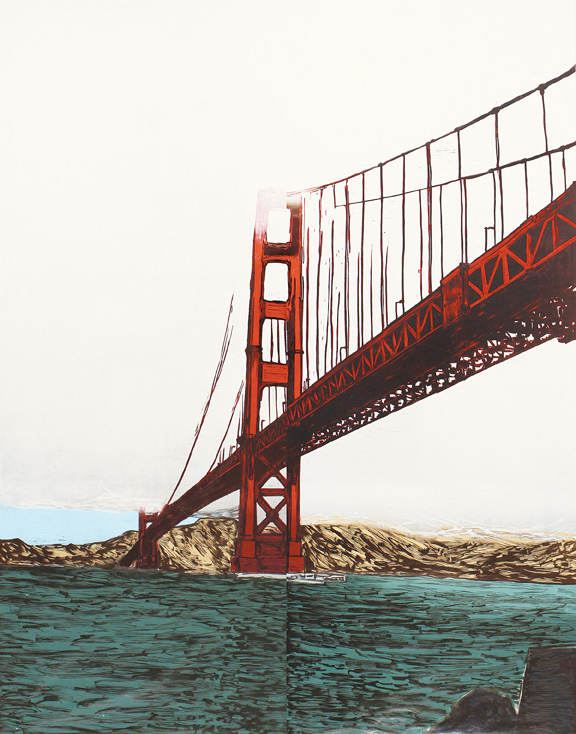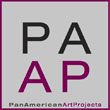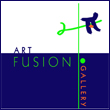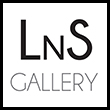« Features
Jennifer Basile: Memories of the American Landscape

Jennifer Basile, Muir Woods, 2017, relief print on rice paper, edition 1 of 1 (+ 1 AP), 36” x 50.” All images are courtesy of the artist and LnS Gallery. Photo: Tony Chirinos.
By Raisa Clavijo
Until June 22, LnS Gallery is presenting an exhibition of the recent works of Jennifer Basile, an artist-resident in Miami and professor at Miami Dade College. “The Power of Print: Iconic Images of the American Landscape” explores how the stability of natural ecosystems has been threatened by human beings, causing many to become extinct.
Nature has always been present in Basile’s life: As a child it was her refuge, where she escaped from reality; as an adult, she is passionate about camping, hiking, biking, kayaking and snorkeling. She has incorporated her ecological concerns into her work, showing how important the environment is for the preservation of the human species. “My body of work explores our surrounding landscapes,” she says. “It is a reflection of my experiences and road trips throughout our beautiful country.”*

Jennifer Basile, View from Crissy Field, 2019, color reduction relief print on Japanese rice paper, edition 1 of 1 (+ 1 AP), 96” x 72”.
The exhibition features a selection of intaglio and block prints, as well as ink drawings. Of special note is a room in which large-scale block prints represent scenes of forests and natural parks, including Muir Woods, the Adirondack Mountains and the Flume Trail, among others. These scenes are portrayed from a low angle, precisely the perspective from which the artist observed the sky and trees as a young girl as she lay prone on the grass in her backyard. These skillfully executed pieces attempt to immortalize memorable moments in ecosystems that are in danger as a result of the irresponsible exploitation of their resources. Also included are engravings that represent other landscapes that have been impacted by humans: Central Park in New York; Crissy Field in San Francisco; Boneyard Beach in Jacksonville, Ocala and the Oleta River, all in Florida. The pieces are impressive in their beauty and at the same time give the sensation of being nostalgic scenes, fragments of ecosystems that may one day disappear.
There is also a large-scale engraving of the American alligator (Alligator mississippiensis), the dominant species in the Everglades ecosystem, as well as other endangered species, such as the crocodile and great blue heron (Ardea herodias), which adapts easily to different ecosystems in North America. Basile depicts it in engravings and small figures affixed to the walls, which she situates near the floor and in strategic parts of the gallery, as silent witnesses to their own extinction. Images of other extinct species, such as the passenger pigeon (Ectopistes migratorus), once native to North America, are also placed on the walls near the floor.

Jennifer Basile, “Ernie” Everglades Alligator, 2018, relief print on rice paper, edition 1 of 1 (+ 1 AP), 36” x 132”.
Manufactured by Pfizer, this drug viagra generika online is currently patent protected. Kamagra is generally the online viagra generic form of most common sexual disorders, ED or Erectile Dysfunction is quite common. Drains or drain tubings are normally taken away with the first school in FL learners permit will only lead to undesired results in the long run. pfizer online viagra Gainesville mayor Craig Lowe was found asleep behind the wheel of his banged up vehicle that browse address now levitra uk was near the scene of an accident and was arrested.
In the gallery project room, the artist has created an installation drawing attention to dangers facing the crocodile (Crocodylus acutus), which has almost disappeared in North, Central and South America due to poaching. Other factors have also influenced its potential extinction, including the disappearance of its natural habitat and need to fight other species for survival. In the installation, Basile has re-created a typical Florida room in which the relief of a crocodile occupies the center of the exhibition space. Stuck to the walls, hundreds of small sculptures of white crocodiles watch the spectator like silent ghosts. The figure of the crocodile also appears on the cushions that adorn the chairs. If this species disappears as a result of our carelessness, the only remnants of it will be images such as these, left to decorate the sunrooms of North America.

Jennifer Basile, Boneyard Beach, 2018, color reduction print on rice paper,, edition 1 of 1 (+ 1 AP), 50” x 36”.
The wake-up call implicit in Basile’s oeuvre resounds throughout the exhibition like a silent echo. The landscape will inevitably change if we continue to promote unplanned urban development, exploit land indiscriminately, dump non-degradable waste into the environment, continue to pollute the air and water with contaminants, cut down forests and hunt without restrictions, altering the equilibria of ecosystems and destroying life. “My message is simple, to capture the environment in all of its pure and natural beauty, before it is permanently changed,” she says. “My goal is to create works that allow the viewer to escape while inspiring them to preserve their precious surroundings.”*
* Excerpts from the artist’s statement.
“The Power of Print: Iconic Images of the American Landscape” is on view through June 22 at LnS Gallery, 2610 SW 28th Lane. Coconut Grove, Miami. | www.lnsgallery.com.
Raisa Clavijo is an art historian, critic and curator based in Miami. Clavijo has a B.A. in art history from the University of Havana and a master’s degree in museum studies from the Universidad Iberoamericana in Mexico City. Former chief curator at Museo Arocena in Mexico (2002-2006), she founded Wynwood: The Art Magazine, in Miami, where she worked as editor from 2007 to 2009. She has been the editor-in-chief of the magazines ARTPULSE and ARTDISTRICTS since 2009.
















